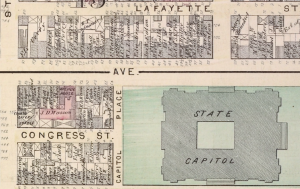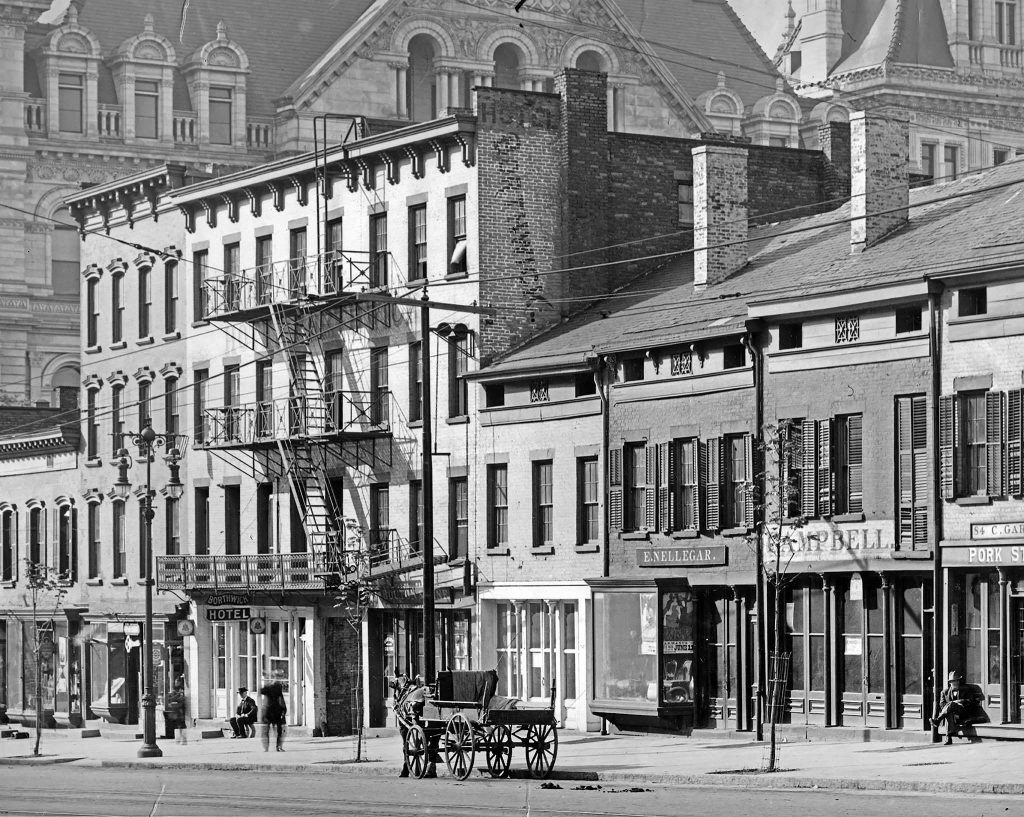Here’s the full view of much of the block of Washington Avenue that existed just west of the Capitol, running from now-lost Capitol Place to South Swan Street. Last week we covered a lot of the venerable businesses that were being pushed out of the block in the beginning of 1919, but we didn’t get into the reason. All these old buildings and businesses had to go in order to make room for a grand new state office building that was planned at the time.
By this time, all the buildings on the opposite side of Washington Avenue were long gone, replaced by the grand new State Education Building, which had been dedicated in October 1912. When it was determined that the business of the State no longer fit neatly within the confines of the Capitol (and in fact, it never did – other buildings around Albany were always in use for some department or another), plans for a new office building were discussed, and a location immediately adjacent to the Capitol was thought most auspicious.
 In 1914, two appraisers appointed by the trustees of public buildings advised “the immediate purchase of the city blocks bounded by Washington avenue, South Swan and State streets and Capitol place.” Earlier that year the Legislature had authorized appraisal of property west of the capitol, and subsequently amended it to include the two blocks north of the Capitol and east of the new education building (now Lafayette Park).
In 1914, two appraisers appointed by the trustees of public buildings advised “the immediate purchase of the city blocks bounded by Washington avenue, South Swan and State streets and Capitol place.” Earlier that year the Legislature had authorized appraisal of property west of the capitol, and subsequently amended it to include the two blocks north of the Capitol and east of the new education building (now Lafayette Park).
“It is said to be the general plan to create a park west of the capitol and to erect a large office building to conform to the architectural lines of the new education building. The state is now paying out thousands of dollars a year for office rent, a large number of the departments being scattered over the city. The original law is said to also contemplate the erection of an office building in Buffalo and one in New York, the whole appropriation to aggregate something like $4,000,000. State Architect Pilcher is now engaged on the plans for the contemplated building.”
In 1918, the Legislature appropriated $700,000 for the purchase of the block of land west of the Capitol; in 1919, an additional $450,000 to begin construction of the new building was appropriated.
So, not only the buildings we’ve been talking about on Washington had to go, but so did everything between South Swan and Capitol Place, and the buildings that were across Washington along Hawk, stretching to Elk. But things moved with their normal pace in New York, and so it was 1918 before the buildings were ordered vacated, and 1919 before it was real. The following article from April 12, 1919, which we’ve pulled highlights from before, gives a sense of the disorganization as reality set in. Forgive some uncertainty in dates, as the original is not very clear, and also forgive the length discussion of liveries in Albany at the end.
Many Old Business Landmarks Will Be Eradicated
Tenants of Property on Blocks to be Taken for New State Office Building Must Vacate May 1
Several Are Still Undecided
Desirable New Place of Business Hard to Find – Hotel Borthwick, “The Cottage” and Old Harris Livery Stable Among the Famous Old Places Doomed.
It’s a case of “We don’t know where we’re going, but we’re on our way” with some of the present tenants of offices and shops in the old block on Washington avenue and Congress street between Capitol place and South Swan street which is to be demolished to make room for the proposed new state office building. The tenants are packing up their belongings preparatory to moving day, but some of them have not found any place to move to and May 1 is now only about 13 days off. Work on razing the old block will be started May 1 and unless the tenants want their property demolished with the block they will have to hurry up.
The state department of health, for instance, which has used the premise at 90 Washington avenue, on the corner of South Swan street, as a storage place for its motion picture apparatus, slides, exhibits, etc., has not found anywhere to locate. While the department has been tenanting the place, the [?] has been utilized for interesting exhibitions of health work, but it is doubtful if these exhibitions will be continued after the department transfers its storehouse to other quarters.
Store There for 60 Years.
The building at 86-88 Washington avenue has been occupied as a general grocery store for about 60 years, first under the name of Slingerland and Son, and for the last 25 or 30 years under the name of J.B. and D.C. Slingerland. Where the store is going next is a matter that has not been determined by its proprietors.
Edwin Nellegar, upholsterer, who was formerly with the W.M. Whitney company but has been in business on his own account for the last 23 years, during which time he has been in the vicinity of the old block, has not decided where he wil move his business. Mr. Nellegar has occupied his present quarters for several years.
J.H. Miller, proprietor of the Borthwick Hotel, has not made his plans. Mr. Miller has had the hotel for only about 10 years, but the building has been used as a hotel for fully 75 years. Alfred Schimpf, electrician and locksmith, who has had his place of business at 72 Washington avenue for 11 years, will move May 1 to 230 Washington avenue. Giuseppe Icolari, barber, who also occupies a part of the building at 72 Washington avenue, is having a hard time to obtain a suitable place for a barber shop at a reasonable price, he declares. Mr. Icolari bought the business two years ago from H.B. Norris, who had conducted a barber shop there for several years and whose father and grandfather conducted the business there before him. Three generations of the Norris family used the same quarters, the business having been started about 60 years ago by the grandfather of H.B. Norris, who came over from England.
The Capitol City News company, which has been in business at 70 Washington avenue for 20 years, doesn’t know where it’s going. Frank F. Schimpf, plumber, will move May 1 to 120 Washington avenue, making the change after 30 years of business at 68 Washington avenue. Another occupant of the premises is Jeu Sing, a Chinese laundryman, who had the foresight and kindness to display a big sign, “On May 1 will move to 13 North Hawk street,” over his door so that the reporter who was interviewing these merchants would not have to battle with the Chinese language to procure the desired information. From the man next door the reporter gleaned the fact that there has been a Chinese laundry at No. 68 for the last 30 years, but that Jeu Sing was a newcomer.
Good Bye to “The Cottage”
At the corner of Capitol place and Congress street is the old green, wooden building that was once a famous hotel. It is now a saloon and is occupied by M.A. Sheedy, who has owned the property for about 15 years. This queer old buiding, known as “The Cottage,” with its old-fashioned square chimney and its odd-colored windows, was owned by William J. Breslin, who opened it as a hotel in [1888?]. Mr. Breslin conducted a hotel there for 23 years and accumulated considerable wealth. The place was known by all statesmen throughout the state, the hotel being in close proximity to the capitol. Could the now dingy looking back rooms speak they could tell stories of many a political deal pulled offer there.
Another hotel occupies the corner at Washington avenue and Capitol place, this being known as Patterson’s hotel. The proprietor, J.F. Patterson, said he had made plans for the future. He has had the business about five years.
The same old block also contains, on the corner of South Swan and Congress streets, a well known livery stable, now no longer in use. The window panes are smashed and the interior is gray with cobwebs. Since the old days when the big stable was the home of stylish turnouts, the motor car and luxurious limousine have come into being and swept away the once fashionable Dobbin with docked tail and shiny harness and the black carriage glistening with its new coat of paint. The old stable still stands, – a relic of the old days when the honk of Fords and screaming siren on the Twin-six Packards were not heard.
The Old Livery Stable
Charles J. Reynolds, for 30 years associated with the Harris family who conducted the livery stable on the corner, and now assistant director of the Bureau of Weights and Measures, is authority for the history of the old stable, and, incidentally, details about other livery stables in Albany, only two of which exist to-day. The stable on the corner was purchased in 1892 by Captain Frank S. Harris who is now with the 51st Pioneer infantry in the Army of Occupation on the Rhine. The livery business was moved there from Maiden lane, where three generations of the Harris family had done business. The business was established by George Harris and was carried on by George Harris, jr., and later by his son Frank for [25?] years, and their stable on Maiden lane was one of the oldest liveries in the city and one of the largest between Buffalo and New York.
Then the automobile came and Fred Harris, after removing to the corner of Swan and Congress streets, saw clearly that the livery business was doomed, so in 1914 he sold out to George Dunnell, who conducted the business there until 1917. Since that time the old stable has been vacant. Before Captain Frank Harris bought the stable it had been used as a livery by Augustus Brewster, who entered business there before 1892.
Mr. Reynolds said the building has been used as a livery for fully [68?] years. He stated that only two out of 11 liveries in Albany are still doing business, these being the one owned by Charles Gunn on North Lake avenue and that of Henry F. Tammany on North pearl street. The others were: George Russell’s livery on State street, [near?] Willett street; John Ebel on Hudson avenue; A.W. Burch, North Pearl street; T. Wilson & Son, North Pearl street; William Wakefield’s livery on Hudson avenue, near Hawk street, which has since been turned into a garage; Charles Tietz’s on Madison Avenue; Matthew De Freest, Hamilton street, near Union; Phil Shaffer, Central avenue, and John Peterson, Sherman street.


Leave a Reply